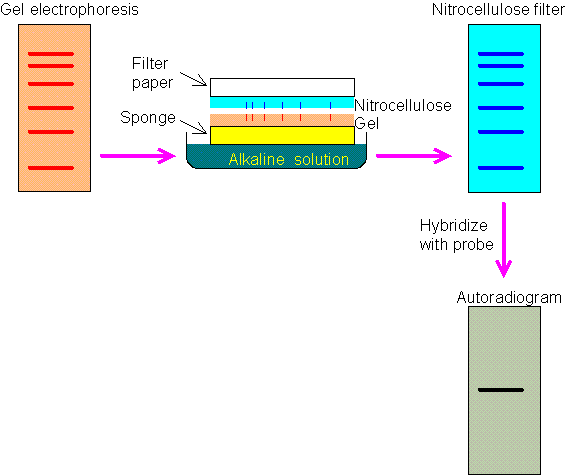
01-10-2014_10-53-17 / блотинг
.doc|
MoBio Contents |
Section D: Blotting Methods and Applications |
|
Chapter 9 |
A | B | C | D | E | F | G | H | I | J | K |
|
|
Following gel electrophoresis, probes are often used to detect specific molecules from the mixture. However, probes cannot be applied directly to the gel. The problem can be solved by three types of blotting methods: Southern blotting, Northern blotting and Western blotting. Southern blottingSouthern blotting is a technique for detecting specific DNA fragments in a complex mixture. The technique was invented in mid-1970s by Edward Southern. It has been applied to detect Restriction Fragment Length Polymorphism (RFLP) and Variable Number of Tandem Repeat Polymorphism (VNTR). The latter is the basis of DNA fingerprinting. Animation of Southern Blotting - From Cold Spring Harbor Lab.
Figure 9-D-1. Southern blotting. (a) The DNA to be analyzed is digested with restriction enzymes and then separated by agarose gel electrophoresis. (b) The DNA fragments in the gel are denatured with alkaline solution and transferred onto a nitrocellulose filter or nylon membrane by blotting, preserving the distribution of the DNA fragments in the gel. (c) The nitrocellulose filter is incubated with a specific probe. The location of the DNA fragment that hybridizes with the probe can be displayed by autoradiography.
Restriction Fragment Length Polymorphism (RFLP) Polymorphism refers to the DNA sequence variation between individuals of a species. If the sequence variation occurs at the restriction sites, it could result in RFLP. The most well known example is the RFLP due to globin gene mutation.
Figure 9-D-2. Restriction Fragment Length Polymorphism (RFLP) resulting from -globin gene mutation. In the normal cell, the sequence corresponding to 5th to 7th amino acids of the -globin peptide is CCTGAGGAG, which can be recognized by the restriction enzyme MstII. In the sickle cell, one base is mutated from A to T, making the site unrecognizable by MstII. Thus, MstII will generate 0.2 kb and 1.2 kb fragments in the normal cell, but generate 1.4 kb fragment in the sickle cell. These different fragments can be detected by southern blotting.
Variable Number of Tandem Repeat Polymorphism (VNTR) Animations from Cold Spring Harbor Lab: DNA Detective
Northern blottingNorthern blotting is used for detecting RNA fragments, instead of DNA fragments. The technique is called "Northern" simply because it is similar to "Southern", not because it was invented by a person named "Northern". In the Southern blotting, DNA fragments are denatured with alkaline solution. In the Northern blotting, RNA fragments are treated with formaldehyde to ensure linear conformation.
Western blottingWestern blotting is used to detect a particular protein in a mixture. The probe used is therefore not DNA or RNA, but antibodies. The technique is also called "immunoblotting".
|


